| |
Heritage Walk
Come stroll back through time and experience the fascinating history of Nairne first hand.
Click here to download a pdf of our Heritage Walk brochure. |
|
| |
The Peramangk
When the Foundation Act of 1834 was signed declaring all land in South Australia to be "waste and unoccupied, the aborigines were, in effect, dispossessed of their lands. This expropriation of land, combined with the smallpox epidemic which swept down the River Murray from the Eastern States, followed by epidemics of measles, influenza and the common cold, led to an early demise of the Peramangk people. Unfortunately, much knowledge of the culture of these gentle people died with them. In the first few years of the settlement, the settlers and aborigines regarded each other with some curiosity and relations were mostly peaceful. The settlers employed aborigines to labour on their farms. But because Europeans lacked an understanding of Aboriginal culture, and because the Aborigines were oblivious to the Protestant work ethic, opinions of the capabilities of the aboriginal people were low.
|
In response to pressure from philanthropists in England, it was decided that Aborigines should be acquainted with British civilisation. Schemes were announced to provide schooling, food and medical supplies. But the policy which allowed all lands of the colony to be open to public sale remained, and it was this policy which finally pushed the Peramangk tribe off their land. Food became scarce as farming by European settlers expanded, forcing Aborigines into ration queues.
By 1850, with disease and malnutrition reducing their fertility and increasing their child mortality, the Aboriginal people of the Ngarrindjeri Nation were in a desperate situation. The Peramangk people left little evidence behind besides some tools and cave paintings found near Nairne and Native Valley. |
| 1839 |
The Founding of Nairne
Matthew Smillie arrived in South Australia from Leith, Scotland in 1839 and immediately purchased 4000 acres of green undulating land north of Mt Barker, part of what is known today as Hay Valley. It included “The Valleys”, where he built his homestead, and the part where the town of Nairne stands today. He did not farm the land himself but invited settlers to take up tenant farming. He showed much foresight when he surveyed part of the land to establish a village settlement. The first peg of the survey which was undertaken in 1839 was placed in the footpath near the Nairne Institute. He named the village Nairne in honour of his wife’s maiden name Elizabeth Corse Nairne.
He generously gifted to the fledgling community a portion of land known today as the Nairne Tennis Courts and Matthew Smillie Park (later split by the railway line) for the community to use as a market place. He also donated another portion of land, next to Nixon Street and abutting Nairne Creek, to be used as the community’s cemetery. There he was interred at his death on March 12 1847, only 8 years after his arrival in Nairne. His grave stands as an imposing monument to his memory.
Elizabeth Smillie is best remembered for her weekly visit to church:
“On a Sunday she would be driven to town on a dray with a big sofa strapped to it, and her servant was a rather tall Afro-American with a silk topper. He would drive her up the hill to church. It must have been quite a sight.”
|
An advertisement appearing in the South Australian Register on 23 November 1839, described the projected town ...
The proposed Township is situated in a beautiful valley, well-sheltered from the prevailing winds, including both sides of a creek, in which there is at all seasons abundance of fine water.
The adjoining hills afford extensive views of Mount Barker and the country around. As the climate is salubrious, and the elevation from the plains considerable, it is a most desirable spot for summer residences, particularly for persons requiring change of air.
The soil is a deep black loam, thickly covered with a rich sward of grass and the neighbourhood abounds with good building freestone and limestone.

|
| 1841 |
Toll road to Adelaide
The early settlers would be astounded at the ease with which we now travel to Adelaide via our freeway system. Back in 1841 the government made it clear they could not afford to continue road building at public expense. On 15 July 1841, the government approved a system whereby trustees administered an act which provided for a levy toll on travellers using the road. Matthew Smillie was a member of this board of trustees. A toll house and gate were erected at Glen Osmond and continued to operate until December 1847, by which time the road was at least functional.
|
The Tolls
For every coach, chariot, chaise, gig, hearse, caravan or other carriage, and every cart, wagon, dray or other vehicle if drawn by one horse or two bullocks.
One shilling - about 10 cents
For every such carriage or vehicle drawn by two horses or four bullocks.
One shilling and six pence - about 15 cents
For every such carriage or vehicle drawn by four horses or six bullocks.
Two shillings - about 20 cents
For every such carriage or vehicle drawn by six or more horses or eight or more bullocks.
Three shillings - about 30 cents
For every such carriage or vehicle drawn by one pony, ass or mule not exceeding thirteen hands high.
Six pence - about 5 cents |
| 1842 |
First flour mill
John Dunn builds the first wind driven flour mill in the state in Hay Valley. Built with a tree trunk as the central support and seven uprights. |
 |
| 1844 |
The Valleys
Matthew Smillie builds The Valleys using local stone, Mica Schist. It has been extensively renovated over the years by private owners. |
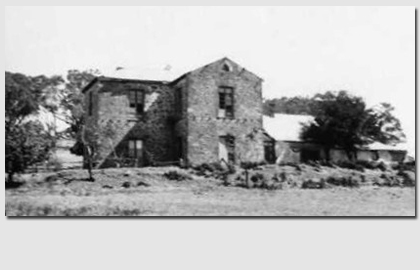 |
| 1845 |
The Crooked Billet
James Shakes established the Crooked Billet which remained an Inn until 1860. Its assembly room was used for council meetings and was where Sir R Torrens gave the first country address on his proposed system of land registration, now known as a “Torrens Title”. |
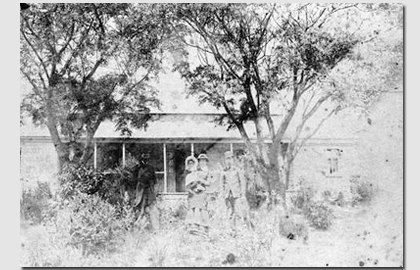 |
| 1851 |
The Tannery
Henry Timmins builds his original tannery down by the creek - later to be used as a bacon factory. The Stables
Housed horses and coaches en route to Sydney and Melbourne, and later became the sale yards for Elder Smith untill the 1950s.
District Hotel
This was also the year that the District Hotel was built on the site of the first public house, and was kept by Mrs Stoddart from 1840 and called "Nairne Arms". The original Policeman's quarters and jail are in the basement. |
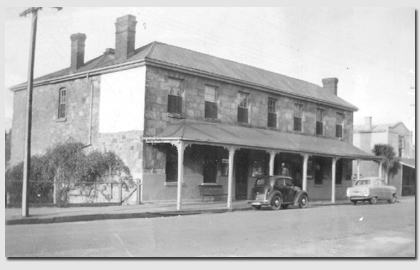 |
| 1852 |
Pioneer cottage
Built for William Smillie, Advocate General of SA, on land given as a wedding gift. |
|
| 1857 |
The Old Mill
Built by Thomas Stoddart, called the Albert Mill and mortgaged for 1,000 pounds to Henry Ayres. Sold to John Dunn in 1864 for 1,500 pounds and operated as a mill until 1906. The Nairne area was denuded of trees to supply wood for the steam driven mill. From 1906 to 1926 it was used as a hardware and grain store by the Beecham family. Later owned by the National Fitness Council during WW2. Currently a private residence. |
 |
| 1870 |
Henry Timmins builds the house and shop now known as ‘Upstairs Downstairs’, in a style reminiscent of his native Cornwall. Initially it was used as a leather shop and later as a butchers. |
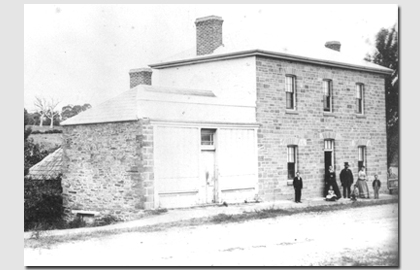 |
| 1876 |
Schools
The first licensed school was opened in Nairne in 1851, with an enrolment of 33 students. The teacher was Mr John Forsyth. Four years later a second school opened, making two schools in the town. This second school lasted until 1870, when it closed.
In 1876, Nairne school received Public School status, and had an enrolment figure of 112. Built by the Education Department, this was the town’s school until 1956 when the current school was built. |
 |
| 1880 |
The Elders building was originally a general store and sometimes used for council meetings. |
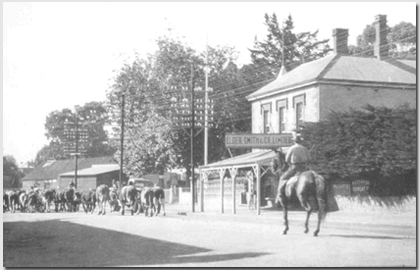 |
| |
Soldiers Memorial Hall
Originally the Oddfellow’s lodge, it was also built in 1880 at a cost of 920 pounds. In 1921 it was purchased by the town as a public meeting place.
In the 1960's the town's Wild West Committee held rodeos to finance extensions to the existing building for a cinema. |
|
| 1883 |
Railway station
Nairne railway station opened in 1883, reducing travelling time to Adelaide to just 2 hours (formerly a 15 hour horse—team journey).
Residents recall, that as children they earned 3 pence helping to drive cattle and pigs from the station to Chapman's factory. Sometimes, the animals were from remote parts of the state and were not used to people and towns, so it was often chaos in the main street. Residents soon learnt to anticipate the event and bolt their gates.
Police station
This was also the year Nairne got its first and only proper Police station, complete with cell blocks and underground tank. The Trooper travelled as far as Dawesley, Kanmantoo, Callington and Harrogate on his white horse, which was stabled at the rear of the building. |
 |
| 1889 |
Amos Howard
With the decline of wheat, and the mills idle, it was indeed fortunate that in 1889 Amos Howard discovered subterranean clover in the Bald Hills Valley. The plaque erected by the Australian Institute of Agricultural Science reads in part...
"He recognised its great promise and was the pioneer of its use in sown pastures. He harvested the first seed and distributed it widely throughout Australia. Through Howard’s foresight, devotion, and tireless effort, the value of subterranean clover was firmly established and it has become the most important pasture plant in Australia.
By transforming millions of acres of infertile soils into productive lands, it has multiplied our flocks and herds. By restoring the fertility of large tracts of worn out wheat lands, it has increased our harvests.
The work of this man has contributed in generous measure to Australia's progress and prosperity."
The plaque does not mention the arduous task it must have been for Howard and his sons to harvest the clover seed by hand! |
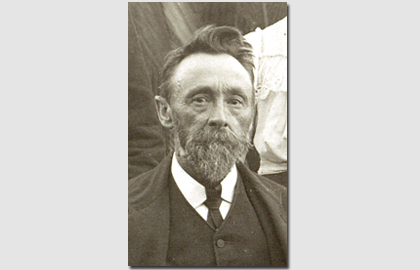 |
| 1899 |
Chapman’s factory
Established by George Chapman and quickly becomes the lifeblood of Nairne. Gradual expansion of the factory provided an increasing number of jobs. In 1926 there were 19 employees. At its peak there were almost 400 employed at the Nairne branch of the company. The factory finally closed in 2002. |
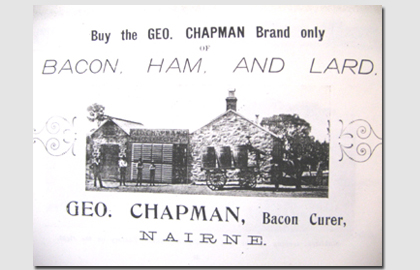 |
| 1904 |
The Institute
Built at a cost of 450 pounds, the Institute has been used at various times as a library, polling booth, bank agency, and for civic and social gatherings. |
 |
| 1939 |
Centenary celebrations
The town’s centenary celebrations were held under The Old Gum Tree that once provided shade for many meetings and marked a watering point for horses.
It was said that its branches stretched across Main Street to touch the verandah of the Millers Arms. |
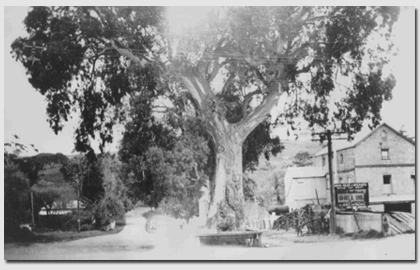 |
| |
|
|
| |
|
|
| |
|
|